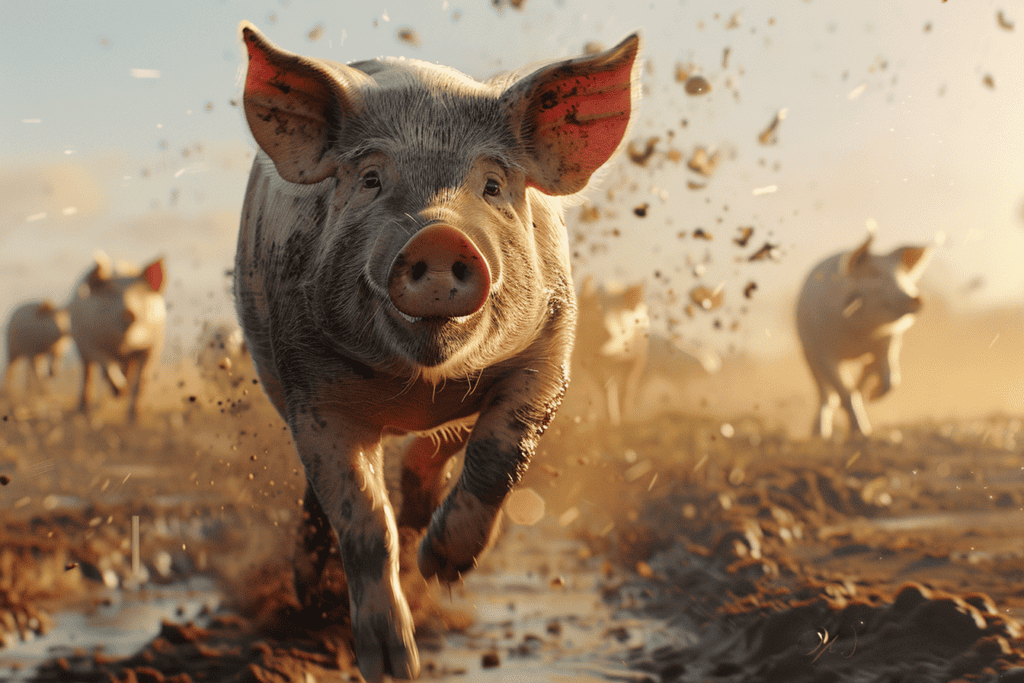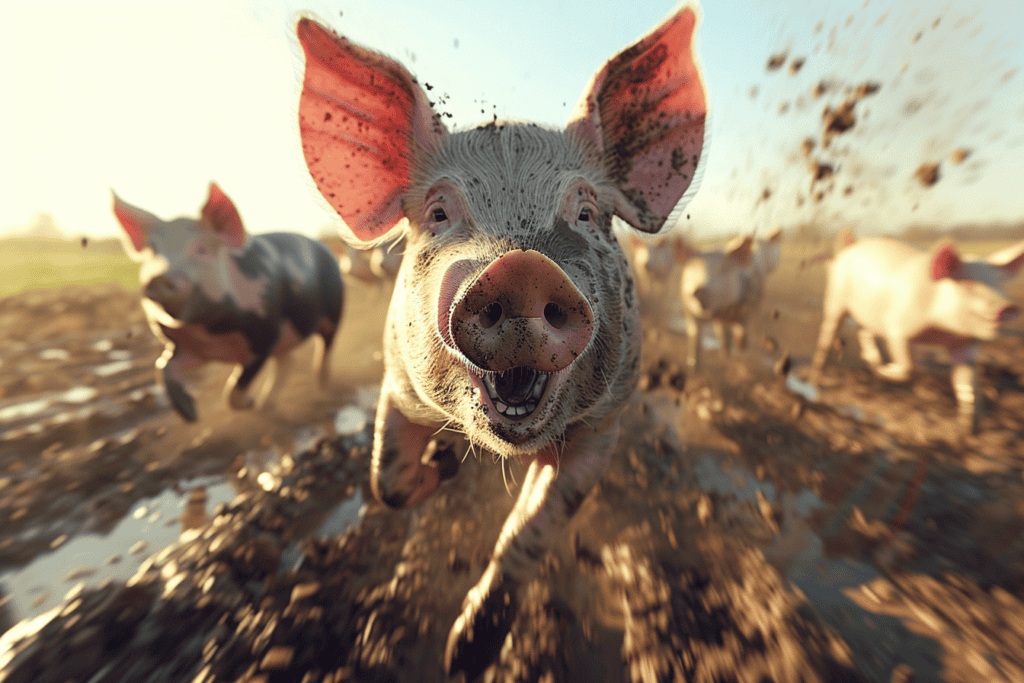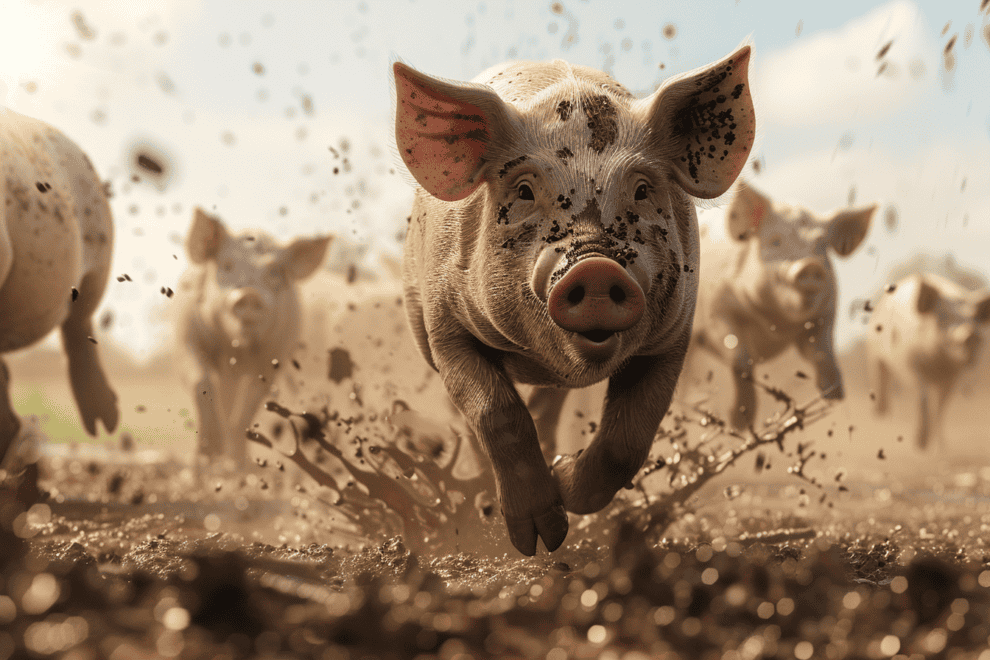Pigs are known for their plump bodies, curly tails, and voracious appetites. However, there is more to these animals than meets the eye.
Pigs are also speedy runners capable of impressive feats of athleticism. Domestic pigs can run at speeds of up to 11 miles per hour, while wild pigs can run even faster.
Pigs are sprinters and can reach their top speed in just a few strides and are also quite nimble and capable of turning on a dime, making them surprisingly agile.
These abilities are not just for show, either. Pigs use their speed and agility to evade predators and find food.

Despite their reputation for being slow and lazy, pigs are actually quite active animals. They enjoy running and playing, and they need plenty of exercise to stay healthy.
In the wild, pigs travel long distances in search of food and water, and they use their speed and endurance to cover large areas of land.
The Speed Spectrum of Swine
Pigs have a reputation for being slow and lazy creatures, but that couldn’t be further from the truth. In fact, pigs are surprisingly fast and agile animals that can run at impressive speeds when motivated or scared.
Piglets are born with a natural instinct to run. As soon as they are born, they start running around, exploring their surroundings and playing with their littermates.
Despite their small size, piglets are surprisingly fast and can run at speeds of up to 6 miles per hour.
As they grow older, piglets become even more active and adventurous. They love to run, jump, and play, and they are always eager to explore new places and try new things.
Their energy and enthusiasm are contagious, and watching them play is a joyous experience.
Domestic vs. Wild: A Comparison of Speed
Domestic pigs and wild boars have different running abilities.
Domestic pigs tend to be larger and slower than their wild counterparts, with a top speed of around 11 miles per hour.
Wild boars, on the other hand, are much faster and more agile, with a top speed of up to 30 miles per hour. They can maintain their high speeds over long distances, making them formidable runners.
It’s worth noting that the speed of pigs can vary depending on their breed, health, weight, and other factors. Some pigs may be faster or slower than others, and their running abilities may change over time.
Anatomy of Acceleration – The Power of Pig Legs

When it comes to sprinters, pigs may not be the first creatures that come to mind. However, these four-legged animals are surprisingly agile and speedy. In this section, we will explore the anatomy of acceleration in pigs.
Pigs’ legs are muscular marvels, capable of propelling their bodies forward at impressive speeds. Their hind legs are especially powerful, providing the majority of the force needed for acceleration.
The muscles in their legs are structured in a way that allows them to generate a lot of force quickly, making them efficient sprinters.
Interestingly, the muscles in pigs’ legs are similar to those found in human legs. This similarity is why pigs are often used as models for studying human anatomy and physiology.
Hooves and Hardiness: Understanding Pig Footwear
Pigs’ hooves are another key factor in their ability to accelerate quickly. Their hooves are hard, sturdy, and provide excellent traction, allowing them to grip the ground and push off with force.
This hardiness also makes pigs’ hooves resilient to the wear and tear of running at high speeds.
Pigs’ hooves are similar to those of other animals in the pig family, including wild boars and javelinas. These animals are known for their agility and speed, making them fascinating creatures to study.
Clever Trotters – The Intelligence Behind the Speed

Pigs are intelligent animals with a remarkable ability to learn and adapt. They are known for their problem-solving skills and can even recognize themselves in a mirror.
Studies have shown that pigs are capable of learning complex tasks and can remember them for a long time.
Pigs have a natural tendency to explore their environment and are curious animals. They are also social creatures that thrive in groups.
Pigs communicate with each other through a variety of vocalizations and body language. They can differentiate between different sounds and respond accordingly.
Can Pigs Be Coached to Be Quicker?
Pigs can be trained to run faster through positive reinforcement. This involves rewarding the pig for exhibiting the desired behavior, such as running faster.
The reward can be in the form of food, praise, or other incentives that the pig finds desirable.
Training a pig to run faster requires patience and consistency.The trainer must first establish a bond of trust and respect with the pig. This can be achieved through regular interaction and positive reinforcement.
Once the pig is comfortable with the trainer, the training can begin. The trainer can use a variety of techniques to encourage the pig to run faster, such as using a target or a lure.
The pig can be rewarded for running faster by receiving a treat or praise from the trainer.
It is important to note that not all pigs are the same. Some pigs may be more trainable than others, and some may respond better to certain training techniques.
The trainer must be flexible and willing to adapt their approach to suit the individual pig’s needs.
Survival Instincts: When Speed Means Safety

Pigs are fascinating creatures that are known for their impressive running abilities. However, their speed is not just for show. Pigs have a strong survival instinct, and their need for speed is often a matter of life or death.
Pigs are prey animals and are constantly on the lookout for predators. Their speed is one of their best defenses against danger.
When threatened, pigs can run at speeds of up to 11 miles per hour. This may not seem fast, but it is impressive when you consider that pigs are not built for speed like cheetahs or gazelles.
Pigs have a unique running style that helps them outrun predators. They have a distinctive gait that involves leaping and bounding, which allows them to cover more ground with each stride.
Pigs also have a zigzag running pattern that makes it difficult for predators to catch them.
Escaping Traps: How Swift Swine Evade Capture
Pigs are not just at risk from predators. They are also in danger of being trapped by humans.
Pigs are often hunted for their meat, and traps are a common method of capture.
However, pigs are intelligent animals and are able to outsmart traps. They have a keen sense of smell and can detect traps from a distance.
When they sense danger, they will often change direction or take a different route to avoid the trap.
Pigs are also able to escape from traps that they have already fallen into. They are strong and can use their powerful muscles to break free from restraints.
Pigs have even been known to chew through ropes or wires to escape.
Frequently Asked Questions

What’s the top speed a pig can reach, and how does it compare to other animals?
Pigs may not be the first animal that comes to mind when you think of speed, but they are surprisingly fast runners.
A domestic pig’s top speed can range from 11 to 15 mph (17 to 24 km/h), while wild pigs can run up to 50 km/h.
Although this may not seem impressive compared to other animals, it’s important to remember that pigs are not built for speed. They are relatively large and heavy animals, and their running ability is impressive considering their size.
Are pigs naturally fast runners, or do they require special training?
Pigs are naturally fast runners and do not require any special training to run. However, like any animal, their running ability can be improved with regular exercise.
Pigs that are raised in environments that allow for ample exercise tend to be faster and more agile than those that are kept in small enclosures.
What are some unique characteristics that allow pigs to run quickly?
Pigs have several unique characteristics that make them fast runners.
Their muscular bodies and strong legs allow them to generate a lot of power and speed. Additionally, pigs have a high number of muscle fibers, which allows them to contract and relax quickly, giving them a burst of speed when needed.
Finally, pigs have a flexible spine, which allows them to move quickly and change direction easily.
Could a pig ever outrun a human, and under what circumstances?
It’s unlikely that a pig could outrun a human in a straight sprint.
However, pigs are surprisingly agile and can change direction quickly, making it difficult for a human to catch them in a confined space.
Additionally, pigs have a lot of stamina and can maintain a steady pace for long periods of time, which could make it difficult for a human to keep up.
What are some of the most surprising facts about pigs’ physical abilities?
Pigs have several surprising physical abilities, including their ability to swim long distances and their excellent sense of smell.
Additionally, pigs have a lot of endurance and can run for long periods of time without getting tired. Finally, pigs are very strong and can lift objects that are several times their own weight.
How do racing pigs get prepared for competitions, and what does their training involve?
Racing pigs are typically trained using a combination of exercise and positive reinforcement. They are given ample space to run and play. In addition, they are rewarded with treats and praise when they perform well.
Additionally, racing pigs are put through a rigorous training regimen. This regimen includes sprinting, agility exercises, and endurance training. By the time they are ready to compete, racing pigs are in top physical condition and ready to take on any challenge.









